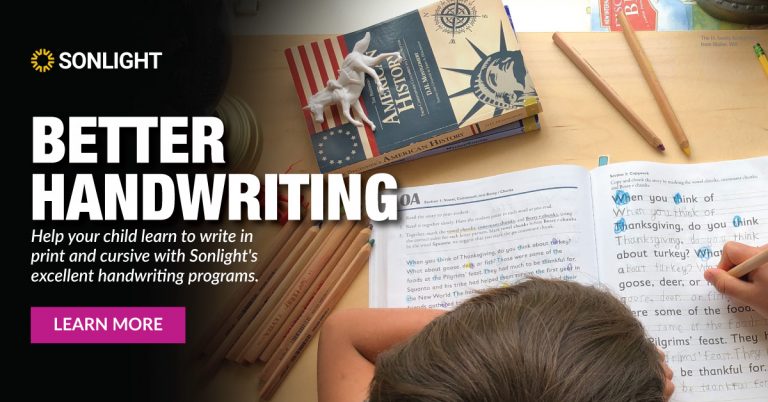Some children almost seem born to write neatly. From their first letters on, they write carefully and neatly, staying between the lines with enviable precision. Most children, however, need a lot more work to write neatly. Here are techniques to help those children put pencil to paper with novelty and more sensory input.
Change Writing Device
Something as simple as giving children a better tool can make a difference. Some children find writing in color more motivating; others are sensitive to the sound of pencils on paper. Try these creative ideas to improve handwriting:
- Use colored pencils instead of regular pencils.
- Try mechanical pencils.
- Test out erasable pens (such as FriXion).
- Use gel pens (for the gliding feeling).
- Use glitter pens.
- Use markers or paint pens. (These do make thicker lines, so it might be harder to stay within the lines, or to trace with for some children.)
- Use dry-erase markers on a dry-erase board (Keep in mind the markers on a slippery surface do require greater fine motor skills to maintain good handwriting, so writing on these surfaces might be more wobbly or larger than normal.)
- Use dry-erase markers on windows or glass doors.
- Use crayons broken in half, or pencils sharpened to about the same length. (Short utensils can improve grip.)
- Use crayons. (The thicker lines might make writing harder for some children.)
- Use pretty or silly pencil grips.
- Use pretty or silly eraser caps.
- Use fancy pens or pencils with feathers, beads, or other decorations attached.
- Use colorful pencils with designs printed on them.
- Use a highlighter to write words and have your child trace inside the highlighter lines.
- Use a pencil to write, and have your child trace over the lines with a highlighter.
- Use oversized pencils.
- Try a weighted pencil grip (weighted pencils or weighted pencil grips can provide extra input and make writing easier for some children).
- Test out a vibrating pencil or vibrating pencil grips.
- Use disappearing ink pens.
Provide Different Sensory Input While Writing
Here are ways to alter the way writing feels and the amount of feedback children getting while writing. These are additional ways to make writing easier or more enticing.
- Try using different brands of pencils.
- Try using different brands of paper. Especially for children with ADHD or sensory processing disorders, the texture or feel of the paper can make a huge difference.
- Print out writing assignments onto different colored paper. Darker colors will be harder to write on, but white gel pens or crayons can often be seen if the color is too dark.
- Try using a Boogie Board writing tablet or other tablet where the written areas change colors as your child writes. Many digital brands can erase the page at the touch of a button.
- Allow them to use an electronic tablet (iPad, etc) with pen to write on.
Motivating Children to Write
- Avoid blaming the child for mistakes. Children already know they aren’t the best writers, but can get discouraged easily if they find their letters are frequently backward or are constantly being reminded to fix mistakes. Instead, try blaming the letters or disguising your correction.
- Practice motor memory skills apart from handwriting. These skills will make handwriting easier, but without feeling like you are adding more writing to their day.
- Have your child be the Letter Police and find their own mistakes rather than have you point them out.
- Try teaching cursive first. Learning to write in cursive is easier for some children and can help somewhat with letter reversals and letter formation.
- Set a marshmallow, mini M&M, dried fruit piece, sticker, or other small treat after each letter, word, or line, depending on how well your child is writing or how much motivation they need.
- Try watching letter formation videos to help them remember the instructions for each letter.

How Sonlight’s Handwriting Programs Can Help
- Sonlight offers 3 different handwriting programs that each work in their own way to motivate children to write. This abbreviated guide might help you choose a program.
1. Handwriting Without Tears
This program helps to break down every step of the process into manageable bits and bite-sized assignments. While the practice may be lacking for a few children who need more help with motor memory, the shorter assignments with lots of white space and coloring can motivate young writers who need to know their assignment is almost over.
2. Reason for Handwriting
A Reason for Handwriting works great for children who want smaller daily assignments of writing just one or two words, and then longer assignments once a week where they can show off their best handwriting and share a Bible message with a friend or family member. The special coloring pages and correlating assignments work great for children who are motivated by showing off their hard work.
3. Getty Dubay
Getty Dubay can help to motivate children who want things to look beautiful. The somewhat fancier letters and slightly artistic design helps make finished work look just a little fancier for the budding artist or illustrator, or appreciator of beauty.
33. Hold a Coronation Celebration. At the end of a day’s handwriting book, celebrate with your child. Have them pick out the best letter, word, or sentence they wrote that day. You can use any judging criteria you want, and even give different words or letters different awards, such as straightest lines, the best use of spacing between letters or words, prettiest or most handsome presentation, fanciest, etc. Each winner gets a sticker, star, or other decoration, and your child gets lots of praise and attention for their best work.
Sensory input is important for budding writers. Once children start writing whole words or sentences, many parents drop the fun extras like writing in sand or using a chalkboard. Try adding back sensory input through use of color, presentation, texture, and feedback from the writing utensil. These tricks can make writing interesting again and motivate children to improve their penmanship.









